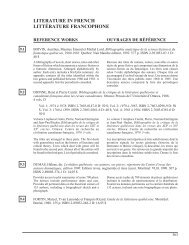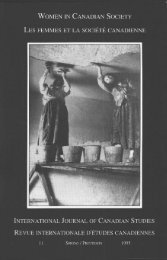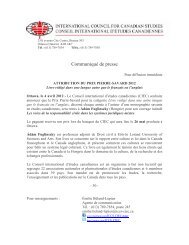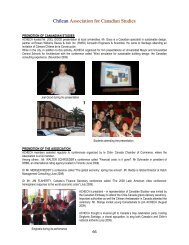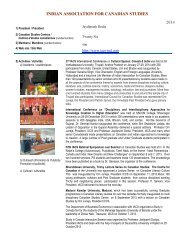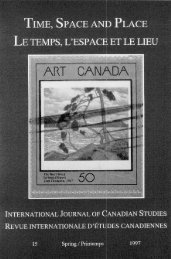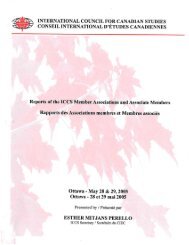IJCS/RIÉCthe abstract modernism of the Anthropology Museum <strong>and</strong> the <strong>in</strong>digenousvernacu<strong>la</strong>r of its artifacts. They are synchronic tensions that reveal coexistent,multiple mean<strong>in</strong>gs <strong>in</strong> an architecture that responds to peculiarities of culture<strong>and</strong> p<strong>la</strong>ce with<strong>in</strong> a tectonically sophisticated rh<strong>et</strong>oric of design. Erickson'sbuild<strong>in</strong>gs possess the accumu<strong>la</strong>ted knowledge of a career that has spannedmore than three decades, <strong>from</strong> the s<strong>in</strong>gu<strong>la</strong>r modernism of the 1950s throughthe pluralistic postmodernism of the 1980s. It embodies ways of know<strong>in</strong>gp<strong>la</strong>ce, space <strong>and</strong> technology that are experientially <strong>in</strong>clusive, knowledge <strong>and</strong>techniques that cannot be elim<strong>in</strong>ated <strong>from</strong> collective memory or professionalcodes by a critically prescribed dec<strong>la</strong>ration of cultural rupture alone.Modernity was conceived as the project of the heroic architect, both masterbuilder <strong>and</strong> foresighted theorist preoccupied with how th<strong>in</strong>gs ought to be, anauthoritarian position widely implied <strong>in</strong> the advocacy of modernism <strong>and</strong><strong>in</strong>fluentially practiced by its figureheads Mies van der Rohe, LeCorbusier <strong>and</strong>Frank Lloyd Wright. 11 Erickson came of age <strong>in</strong> this <strong>in</strong>tellectual climate.However, his work always suggested a concern for the mediation of howth<strong>in</strong>gs were <strong>and</strong> how th<strong>in</strong>gs are—a postmodern cultural construct, but one thatproved, for Erickson, unavoidable <strong>in</strong> the Canadian Northwest wheredifference <strong>and</strong> diversity are operative cultural facts of life. There is little socialhierarchy <strong>in</strong> <strong>Canada</strong>'s decentered, multi-cultural experience that “l<strong>in</strong>ks upneatly” (Coll<strong>in</strong>s, 1989, p. 114). The master-narrative of modernism simplycould not accommodate such h<strong>et</strong>erogeneity; neither could any traditionallyconceivedideology of national identity <strong>in</strong> Canadian art <strong>and</strong> architecture.If there is a uniquely Canadian edge to the reassessment of Erickson's“modern” architecture, it may well lie <strong>in</strong> postmodern culture's realization thatcontemporary civilization is fragmented <strong>and</strong> conflicted. Cultural negotiation,<strong>in</strong>volv<strong>in</strong>g a cont<strong>in</strong>ual decenter<strong>in</strong>g <strong>and</strong> recenter<strong>in</strong>g of dom<strong>in</strong>ant <strong>and</strong>marg<strong>in</strong>alized cultures rather than a simple struggle for dom<strong>in</strong>ance, figuressignificantly <strong>in</strong> postmodern theory (see especially Gramsci, 1971; Coll<strong>in</strong>s,1989). This describes the Canadian situation; there is no discr<strong>et</strong>e architecturalexpression that is properly or holistically “Canadian.” 12 Erickson'sarchitecture neither seeks to representationally revive a lost vernacu<strong>la</strong>r nor toteleologically idealize progress. In the architect's own words, his work is “acontemporary evocation of the spirit of past experience, <strong>in</strong>volv<strong>in</strong>g a merger ofutility, culture, <strong>and</strong> beauty of p<strong>la</strong>ce” (Erickson, 1988, p. 184). It underscoresthat architectural mean<strong>in</strong>g is not def<strong>in</strong>ed by formal constructs alone. As such, itis beyond period style. It simply becomes one way of com<strong>in</strong>g to terms withtraditions of the past, uniqueness of p<strong>la</strong>ce, <strong>and</strong> the conflicts they engender <strong>in</strong>the present.Notes1. A prelim<strong>in</strong>ary version of this paper was presented at the 1991 Annual Me<strong>et</strong><strong>in</strong>g of theUniversities Art Association of <strong>Canada</strong> <strong>in</strong> a session entitled “Modernism <strong>in</strong> CanadianArchitecture.”40
The Architecture of Arthur Erickson: Redeem<strong>in</strong>g Modernity2. Few cultural critics have resisted cit<strong>in</strong>g the <strong>in</strong>fluence of architectural theorists <strong>and</strong>architecture as progenitors of postmodern sensibilities; recurrent references to RobertVenturi <strong>and</strong> Charles Jencks, the Piazza d'Italia <strong>and</strong> the Portl<strong>and</strong> Municipal Services Build<strong>in</strong>gappear <strong>in</strong> the cultural studies literature (see especially, Jameson, 1991; Harvey, 1989; Gitl<strong>in</strong>,1989; Jameson, 1983; <strong>and</strong> Habermas, 1981). The media hype that accompanied the rise ofpostmodernism was also considerable. It is worth recall<strong>in</strong>g, especially with regard to thepopu<strong>la</strong>rization of postmodernism through its architectural imagery, that Phillip Johnson'sAT&T Tower graced the cover of New York Magaz<strong>in</strong>e <strong>in</strong> 1978 <strong>and</strong> that the shelter magaz<strong>in</strong>e,M<strong>et</strong>ropolitan Home, was virtually born of the earliest impulses of postmodern design.3. The discr<strong>et</strong>e construction of the modernism/postmodernism dialectic affords a reasonableframework for juxtapos<strong>in</strong>g problems of formal expression <strong>and</strong> period specific architecturalideology that are raised directly by the nature of Arthur Erickson's work. Themodernism/postmodernism dialectic is but one of several conceptual juxtapositions thatform key conceptual po<strong>in</strong>ts of departure for consider<strong>in</strong>g postmodernism as a culturalconstruct. A parallel breakdown of clearly-cut dist<strong>in</strong>ctions b<strong>et</strong>ween high culture <strong>and</strong> mass,or popu<strong>la</strong>r culture, is also prom<strong>in</strong>ent <strong>in</strong> the postmodern discourse, (see especially Huyssen,1986). The socio-economic construction of postmodernism focuses on the emergence ofnew features of culture <strong>in</strong> a contemporary soci<strong>et</strong>y dom<strong>in</strong>ated by multi-national corporatecapitalism, <strong>and</strong> mass-mediated, consumer-oriented communication systems, (see especiallyJameson, 1983; Harvey, 1989; <strong>and</strong> Habermas, 1975). While this broader contextualframework <strong>in</strong>forms the consideration of Erickson's work, it also m<strong>and</strong>ates an <strong>in</strong>-depthdiscussion of the cultural problematics of <strong>Canada</strong> positioned <strong>in</strong> a <strong>la</strong>rger North Americansituation that deeply affects its socio-economic <strong>and</strong> political situation which is beyond thescope of this essay.4. For an <strong>in</strong>formative review of the history of modernity which explores <strong>and</strong> contextualizes theimplications of postmodernism's reactionary, anti-modernist stance see Habermas, 1981.5. See especially Jameson, 1991, chapter 2, “Theories of the Postmodern.” Like manypostmodern critics <strong>in</strong> the cultural studies arena, Jameson is <strong>in</strong>sufficiently <strong>in</strong>formedconcern<strong>in</strong>g the doma<strong>in</strong> of architectural history which his work appropriates; evidence of thisis his cont<strong>in</strong>ual conf<strong>la</strong>tion of the contributions of Mies van der Rohe, Le Corbusier <strong>and</strong> FrankLloyd Wright <strong>in</strong>to a s<strong>in</strong>gu<strong>la</strong>r doctr<strong>in</strong>e of modern architecture.6. It can be argued that the historiography <strong>and</strong> monuments of modern architecture, particu<strong>la</strong>rly<strong>in</strong> North America, demonstrate considerable awareness of regional specificity. Indeed,regionalism, which connotes neither “modernism” nor “postmodernism” per se, necessarily<strong>in</strong>corporates the h<strong>et</strong>erogeneity of conflict<strong>in</strong>g styles; the “modern” works of Wright, LouisKahn <strong>and</strong> Richard Neutra, to cite a few key examples, tog<strong>et</strong>her with those of Erickson,provide cases <strong>in</strong> po<strong>in</strong>t. However, universal pr<strong>in</strong>ciples underlie regional concerns <strong>in</strong> thearchitecture of such modernists; regional d<strong>et</strong>erm<strong>in</strong>ants of culture <strong>and</strong> site can act <strong>in</strong> consortwith the non-<strong>in</strong>digenous factors of tectonics, space <strong>and</strong> expression.7. I refer here to Charles Jencks's dec<strong>la</strong>ration of the death of Modern Architecture on July 15,1972 with the demolition of the Pruitt-Igoe Hous<strong>in</strong>g Project (M<strong>in</strong>oru Yamasaki, St. Louis,Missouri, 1952-55). Hailed as an exemp<strong>la</strong>r of modernism as dictated <strong>in</strong> Le Corbusier'spr<strong>in</strong>ciples for mass hous<strong>in</strong>g, the project won a prestigious design award <strong>from</strong> the AmericanInstitute of Architects at the time of its design <strong>in</strong> 1951. Barely 20 years <strong>la</strong>ter, the 14-story s<strong>la</strong>blik<strong>et</strong>owers were v<strong>and</strong>alized to such a degree that, <strong>in</strong> spite of concerted, <strong>and</strong> expensiverehabilitation efforts, the muti<strong>la</strong>ted projects were deemed unsalvageable. The build<strong>in</strong>g's“universal” modern style proved to be at odds with the architectural codes <strong>and</strong> expectations ofits low-<strong>in</strong>come <strong>in</strong>habitants (see Jencks, 1977, p. 9).8. Although Erickson's dismissal of the stage-s<strong>et</strong> qualities of such works was broadly cast,much of his wrath was directed toward Michael Graves's w<strong>in</strong>n<strong>in</strong>g scheme for the widelypublicized 1979 Portl<strong>and</strong> Municipal Services Build<strong>in</strong>g comp<strong>et</strong>ition. Erickson's entry to thiscomp<strong>et</strong>ition was not successful, <strong>and</strong> he decried Graves's failure to comprehend fully thecontext <strong>and</strong> sense of p<strong>la</strong>ce of the Pacific Northwest. Graves's scheme, compl<strong>et</strong>ed <strong>in</strong> 1982, is ablock-like tower, ris<strong>in</strong>g <strong>from</strong> a colonnade that hugs the stre<strong>et</strong>; decorated with swags,garl<strong>and</strong>s, <strong>and</strong> pi<strong>la</strong>sters abstracted <strong>from</strong> a C<strong>la</strong>ssical vocabu<strong>la</strong>ry of design, it is pa<strong>in</strong>ted <strong>in</strong> thepastel shades often associated with postmodern architecture of the early 1980s. In contrast,the Erickson scheme, which featured an arcade, considerably recessed <strong>from</strong> the stre<strong>et</strong>,41



